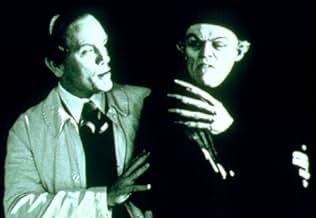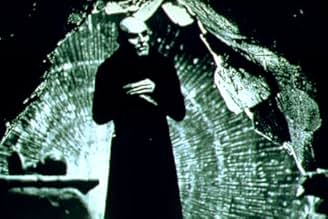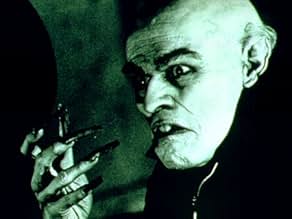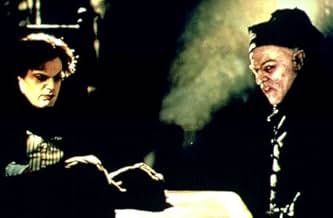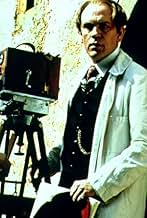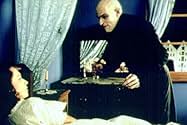Die Dreharbeiten zu Nosferatu (1922) werden durch die Tatsache behindert, dass der Star Max Schreck die Rolle eines Vampirs weitaus ernster nimmt, als dies menschlich möglich erscheint.Die Dreharbeiten zu Nosferatu (1922) werden durch die Tatsache behindert, dass der Star Max Schreck die Rolle eines Vampirs weitaus ernster nimmt, als dies menschlich möglich erscheint.Die Dreharbeiten zu Nosferatu (1922) werden durch die Tatsache behindert, dass der Star Max Schreck die Rolle eines Vampirs weitaus ernster nimmt, als dies menschlich möglich erscheint.
- Für 2 Oscars nominiert
- 16 Gewinne & 30 Nominierungen insgesamt
- Henrik Galeen
- (as John Aden Gillet)
- Paul - Camera Assistant
- (as Nicholas Elliot)
- Innkeeper
- (as Milos Hlavak)
- Drunken Woman
- (as Sacha Ley)
- Old Woman
- (as Marie Paule Van Roesgen)
Empfohlene Bewertungen
The movie asks us to imagine: What if Max Schreck, the mysterious guy who gave what is still considered one of the best vampire performances ever, did so well because, well, he really was a vampire? The skulking creature, we are to imagine, was finagled into performing in "Nosferatu" for legendary cinema pioneer F.W. Murnau. The story then follows as the crew makes the movie dealing with all sorts of difficulties, not the least of which is the star's habit of snacking on cameramen.
Among the film's many virtues is its portrayal of filmmaking in what was really its dawn as a form of art and commerce. People like me, who have trouble with silent movies may gain an additional appreciation for the work and craft that went in to them, and realize that while they may seem hokey and stylized to us now, they had a beauty and substance that was all their own, and still is.
John Malkovich turns in a great performance as the visionary Murnau (who, while tortured, must be a genius because he always gets it in one take). It is a characteristic Malkovich role, a rationalist given to bouts of fury, and it is as much fun to see him discourse pretentiously on the science and art of the moving image as it is to see him pitch a fit ("Albon, a NATIVE has wandered into my FRAME!").
The core of this movie, however, and deservedly so, is Willem Dafoe's unforgettable portrayal of Schreck. This is not your slick-talking Anne-Rice undead-Vogue kinda vampire. Schreck is the next thing up from a rat, squatting in filth and clicking his claws, and Dafoe is able to inspire laughter as well as fear, and even pathos. He makes us imagine what a rotten existence it must be, to have eternal life alone in a rotting ruin and a withered body. He and Malkovich have some great scenes together, including a sick, hilarious moment when Schreck and Murnau try to hammer out who on the crew may or may not be snacked upon (the cinematographer is necessary, it seems, but the script girl is negotiable).
The movie functions best as a sendup of moviemaking, as the harried Murnau must deal with temperamental actors, unfriendly locals, blood-sucking undead, and other hazards of the movie trade. At one point, Murnau must leave to calm the investors, a scene I really wish had been included. Some of the best moments are those of the age-old creature of the night attempting to take direction and find his "motivation." Everyone is afraid of Schreck, but admire the dedication that keeps him in character all the time (he's a Method actor, explains Murnau, he studied with Stanislavsky). The movie makes its point rather neatly, that filmmakers, and by extension filmmaking itself, have a way of sucking the life and blood out of you. Anyone who has ever had to shoot a movie on location will attest to this.
If I have a complaint about the movie, it is only that after its extreme cleverness, it settles for a somewhat straightforward horror-style denouement. Myself, I would have thought the vampire would end up moving to Berlin and getting an agent, a swimming pool, and a meeting with Ovitz. Still, the movie clearly makes its point: an auteur driven by a mania for artistic perfection can be more of a monster than something that just lives in a cave and drinks blood from your neck.
This theme makes it of course a must for the ancient horror fans. Lots of footage and trivia of the 1922 masterpiece are shown and that's a real extra value for true cinema buffs ! But of course, this movie reaches far above average thanks to the brilliant performances. A totally disguised Willem Dafoe is absolutely amazing in his role of Max Shreck. It's like looking at the real Schrek...the resemblance is terrific. His appearance (especially the long nails) give you the creeps whenever he's on screen and his voice haunts your head every time he says something. Dafoe never gives away a bad performance but this one is extraordinary. And of course,the same can be said about John Malkovich...his portrayal of director F.W. Murnau is extremely realistic and believable. He plays Murnau as the man who slowly goes insane because he tries to be too perfect. An amazing performance !!
There aren't many shock effects to detect in this movie but that's rather normal, right ? After all, it's more like a costume-drama than it is horror. The lack of exiting scenes is made up by the constant presence of tension and an extremely appropriate atmosphere. Also, a perfect image of Eastern Europe in the 1920's is presented to the audience. All these aspects make a much better movie then just some ordinary slashing and slicing throats. A must see !!
Having assembled his crew, Murnau (John Malkovich) travels to a small town in Czechoslovakia, where he intends to recreate before his camera the story of Bram Stoker's "Dracula". Set on creating the most realistic vampire film, Murnau secretly recruits a real vampire (Willem Dafoe), promising to recompense the creature with leading lady Greta (Catherine McCormack). Murnau cautiously introduces the vampire to his producer Albin Grau (Udo Kier) and scriptwriter Henrick Galeen (John Gillet) as "Max Schreck", a truly professional "method actor" trained by Stanislavsky. Schreck performs his scenes suspiciously well, only appearing on the set at night and in character, keeping his end of the bargain with the director. Soon, however, his blood thirst takes over and he fearlessly threatens to eliminate, one by one, Murnau's most dispensable crew members.
Shadow of the Vampire stems from the premise that its protagonist, the fictional Murnau (Malkovich), must hire a real vampire in order to ensure a truly authentic representation of the vampire character, "Count Orlock", for his film Nosferatu. The viewer who seeks a more accurate portrayal of the making of the real Nosferatu may find this premise strained and far-fetched, and may even consider the film's ensuing humor a bit aimless. However, Shadow of the Vampire integrates the humorous premise to its metaphorical exploration of the artistic process and of the inevitable struggle between the star, the director and the crew. (In one scene, Schreck tries to secure his interests --a new victim-- by negotiating with Murnau. He reflects: "I don't think we need the writer any longer.") Aside from the film's complex treatment of the film within the film and of the character within the character (where Shadow of the Vampire re-presents Nosferatu, and Shadow's cast plays Nosferatu's cast), the film's most enjoyable aspect is its careful reconstruction of specific Nosferatu scenes. When demonstrating how Murnau shoots these well-known scenes, Shadow's own shots shift between black & white and color; from a full-frame to one enclosed by an iris. Shadow's recreation of the classic scenes are often accompanied by Murnau's off-screen voice-over instructions to the actors, who in turn stop in mid-shot, enter, or exit the frame. These choices offer a fantastic depiction of silent film technique, and they as well add new life and a sort of magical dimension to the original Nosferatu scenes. Undoubtedly, Shadow of the Vampire may be most fully appreciated by the viewer that has already developed a sensitive appreciation for Nosferatu's unforgettable images. Still, Shadow of the Vampire may be enjoyed as well by those fascinated by filmmaking or --as Shadow's Murnau put it-- by "the science of the creation of memory."
This is an inventive film that looks at how far art will go to create. The director Murnau seems as driven by the creative process as Shreck is by his lust for blood. This comparison is carried through the whole film until the inevitable showdown between the two drives. The setup itself is fascinating but the comparison between the two men makes it even better.
The film is well shot and uses the different cameras well. It looks really good and mixes bright shots with shadowy darkness really well. It also benefits from a good cast. Malkovich is excellent as the driven director who easily becomes a monster himself but Dafoe is even better. Despite being almost unrecognisable under the make up, Dafoe manages to bring humanity to his monster he also brings some humour without making his a comedy role. Elwes is underused, but Izzard is great as a bad 1920's actor!
Overall this may not inspire interest in everyone but it has a great cast and a good central story. The comparisons drawn between Murnau and Shreck only improve what is already a very enjoyable film.
Wusstest du schon
- WissenswertesBased in part upon a legend that Max Schreck was in reality a vampire which is why he played the role of Orlok/Dracula so well. Some variations of the legend suggest that Nosferatu, eine Symphonie des Grauens (1922) was the only film Schreck made, though in reality he was already a stage and screen veteran by the time Nosferatu was shot, and would appear in many non-vampiric roles before his death in 1936.
- PatzerThere is a reflection of Count Orlock's head in the mirror moments after a big deal was made about the fact that he cast no reflection in the same mirror (although this is possibly a deliberate nod to Nosferatu, eine Symphonie des Grauens (1922) in which a similar error was made).
- Zitate
[Asked what he thought of the book, Dracula]
Max Schreck: It made me sad.
Albin: Why sad?
Max Schreck: Because Dracula had no servants.
Albin: I think you missed the point of the book, Count Orlock.
Max Schreck: Dracula hasn't had servants in 400 years and then a man comes to his ancestral home, and he must convince him that he... that he is like the man. He has to feed him, when he himself hasn't eaten food in centuries. Can he even remember how to buy bread? How to select cheese and wine? And then he remembers the rest of it. How to prepare a meal, how to make a bed. He remembers his first glory, his armies, his retainers, and what he is reduced to. The loneliest part of the book comes... when the man accidentally sees Dracula setting his table.
- Crazy CreditsCredits end with the sounds of the camera filming and of the phonograph which set the mood for the actors.
- VerbindungenEdited from Nosferatu, eine Symphonie des Grauens (1922)
Top-Auswahl
- How long is Shadow of the Vampire?Powered by Alexa
Details
- Erscheinungsdatum
- Herkunftsländer
- Sprachen
- Auch bekannt als
- La sombra del vampiro
- Drehorte
- Vianden, Luxemburg(Castle interior scenes)
- Produktionsfirmen
- Weitere beteiligte Unternehmen bei IMDbPro anzeigen
Box Office
- Budget
- 8.000.000 $ (geschätzt)
- Bruttoertrag in den USA und Kanada
- 8.293.784 $
- Eröffnungswochenende in den USA und in Kanada
- 150.171 $
- 1. Jan. 2001
- Weltweiter Bruttoertrag
- 11.155.214 $
- Laufzeit1 Stunde 32 Minuten
- Farbe
- Sound-Mix
- Seitenverhältnis
- 2.35 : 1
Zu dieser Seite beitragen





